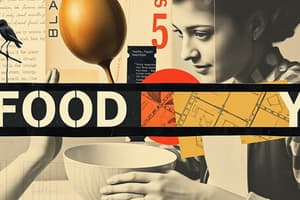Podcast
Questions and Answers
Bacteria needs conditions represented by the acronym FATTOM, which includes Food, Acidity, Time, Temperature, Oxygen, and ______.
Bacteria needs conditions represented by the acronym FATTOM, which includes Food, Acidity, Time, Temperature, Oxygen, and ______.
Moisture
Four common symptoms of food borne illnesses include fever, headache, nausea, and ______.
Four common symptoms of food borne illnesses include fever, headache, nausea, and ______.
Vomiting
Foods that require time and temperature control for safety are often called ______ foods.
Foods that require time and temperature control for safety are often called ______ foods.
TCS
The temperature danger zone is defined as temperatures between ______ and 135°.
The temperature danger zone is defined as temperatures between ______ and 135°.
Food should not be held in the temperature danger zone for more than ______ hours.
Food should not be held in the temperature danger zone for more than ______ hours.
Flashcards
What are the conditions that bacteria need to grow?
What are the conditions that bacteria need to grow?
The conditions that bacteria need to grow. These include food, acidity, time, temperature, oxygen, and moisture.
What is the temperature danger zone?
What is the temperature danger zone?
A range of temperatures where bacteria can rapidly multiply, increasing the risk of foodborne illness.
What are TCS foods?
What are TCS foods?
Foods that require careful temperature control to prevent bacterial growth and food poisoning.
What are the recommended cooking temperatures for ground meat, poultry, and seafood?
What are the recommended cooking temperatures for ground meat, poultry, and seafood?
Signup and view all the flashcards
What are some common symptoms of foodborne illness?
What are some common symptoms of foodborne illness?
Signup and view all the flashcards
Study Notes
Foodborne Illness Factors
- Bacteria need 6 factors to grow (FATTOM): Food, Acidity, Time, Temperature, Oxygen, Moisture
Foodborne Illness Symptoms
- Common symptoms include fever, headache, nausea, and vomiting
- Food can look and smell normal even when spoiled
Time and Temperature Control Foods
- Examples of TCS (Time and Temperature Control for Safety) foods include fish, milk, beans, tomatoes, meat, and rice
Temperature Danger Zone
- The temperature danger zone is between 41°F and 135°F
- Food should not be held in the danger zone for more than 4 hours
Safe Food Temperatures
- Refrigerator: 41°F
- Seafood/Beef/Pork: 135° - 145°F
- Poultry/Reheating food: 165°F
- Frozen food: 0°F
- Holding Hot Food: 135°F
- Ground Meat: 155°F
Studying That Suits You
Use AI to generate personalized quizzes and flashcards to suit your learning preferences.




